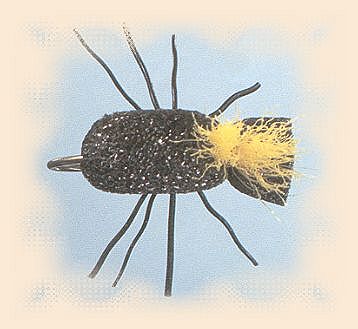Foam Beetle
By Skip Morris
The Foam Beetle has become a new stand-by, and tying it is sheer
simplicity. Some think that the Foam Ant's tying is even simpler, but who
really cares? Experienced tiers bebating this, is akin to chefs debating
weather it is easier to boil an egg or warm up canned soup. The point is,
tying these two patterns is about as easy as tying gets.
The Morrisfoam Beetle came about soon after my entomologist-fly fisher
friend Rick Hafele told me about his Master's thesis. For his thesis, Rick
set special traps in a western Oregon creek from early spring to late fall.
That he found were a lot of beetles during July and August - great creek-fishing
months. This told me that I needed an expecially buoyant beetle, since the Foam
Beetle simply has too much hook and too little foam to stay afloat on the
tumbling waters of most creeks. The obvious answer was less hook and
more foam, and in this case obvious worked. The Foam Ant is tied in much
the same manner as the Morrisfoam Bettle, and in both, the foam-to-hook ratio
is easily varied to suit conditions.
. . . if you are fishing lively water, I suggest you tie your Foam Ants with
little hook and plenty of foam. ~ Skip
Recipe: Foam Beetle
Hook: Standard dry fly, sizes 18 to 8. (The hook shown
is a Daiichi 1170).
Thread: Black 8/0 or 6/0.
Legs: Black elk hair or fine rubber-strands.
Body: Black soft-foam strip.
Indicator: Bright yellow poly yarn.
Tying Steps:

1. Start the thread two-thirds up the shank. Tie in a strip of foam atop
the hood (the strip should be about gape wide), and then spiral the thread
down the foam and shank to the bend. (If you fish, you can go slightly beyond
the bend to create more beetle-body.) Take a few thread-turns at the bend.
Trim the stub end of the foam, if necessary.
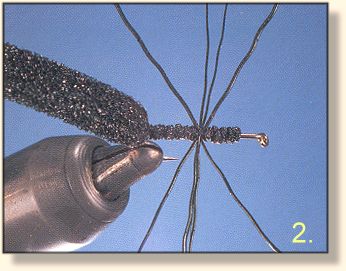
2. Advance the thread to midshank; there, tie in three to five elk
hairs across the shank with crisscrossed thread-turns. The turns
should be tight enough to flare the hairs.
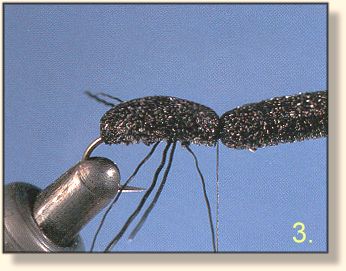
3. Advance the thread three-quarters up the shank (some tiers advance it
nearly to the eye.) Pull the foam forward and down. Hold the foam down
under slight tension as you work a couple of thread-turns over it and
tighten them. Now you can release the foam.
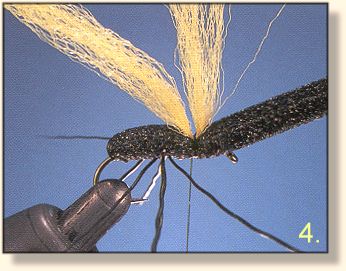
4. Loop a section of bright yellow poly-yarn around the thread, take a
turn of thread as you slide the poly-loop into place atop the fly, then
pull the yarn back as you take a couple of thread-turns right in front of it.
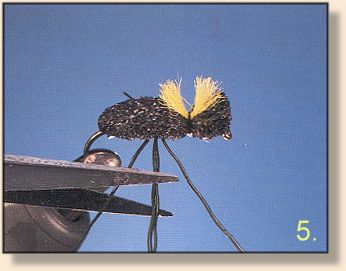
Step 5. Trim the foam so that it ends over the eye, as a short head.
Draw back the yarn and add a Skip's whip [see below] against the
front of the yarn. Trim the elk hairs to leg length. Draw up the
yarn, and then trim it to a short tuft. (You can trim the foam head
so that it appears round from beneath.)
Skip's Whip
I used to call this the wet whip finish, but its name has become streamlined:
Skip's whip. Skip's whip is very secure because it has head cement all
through it.
Many of the foam flies . . .are completed with a whip finish that squeezes down into
compressed foam - no thread head. For these, the Skip's whip is usually the best
and easiest solution.
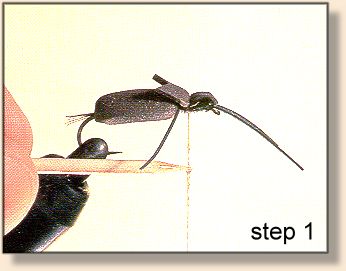
1. To start the Skip's whip, add head cement or epoxy sparingly along 1/4 to 1/2 inch
of the thread near the hook.
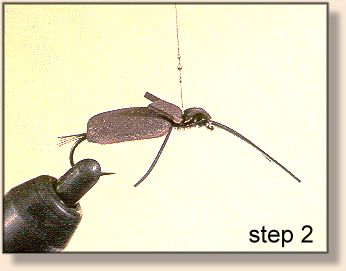
2. Add two to four thread-turns at the whip-finish site.
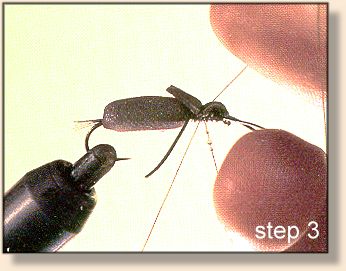
3. Cross the thread over itself in preparation for a whip finish. Cross the thread
near the hook so that you don't scrape off the cement or epoxy. Whip
finish the thread as usual, and then trim it. ~ Skip Morris
Publishers Note: For COMPLETE instructions on doing a whip-finish by hand,
see: Whip Finish Without Tools!
Credits: From Tying Foam Flies by Skip Morris,
Published by: Frank Amato Publications, Inc.
P.O. Box 82112, Portland Oregon 97282
Phone: 503-653-8108
|

